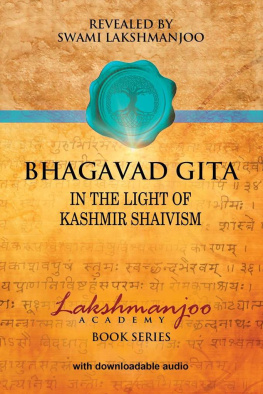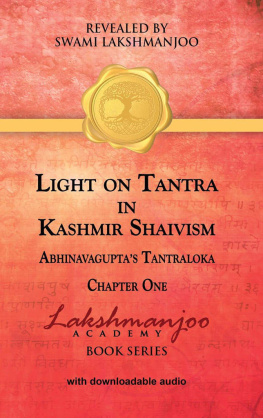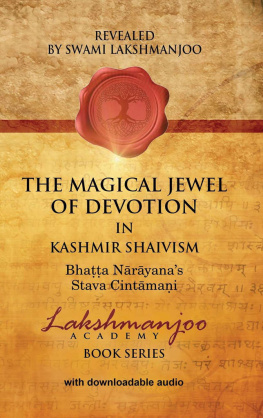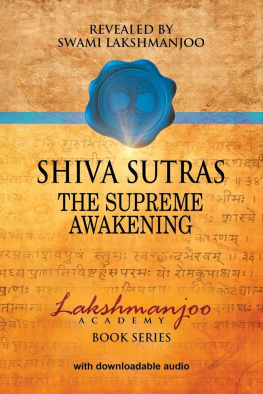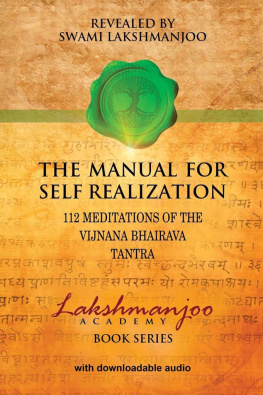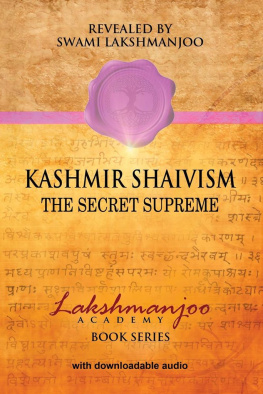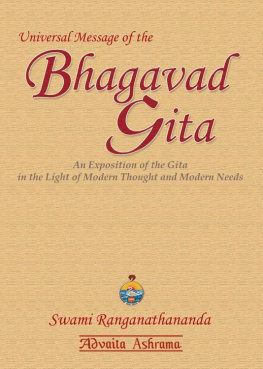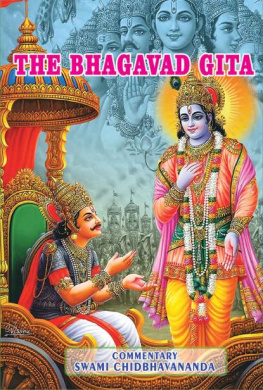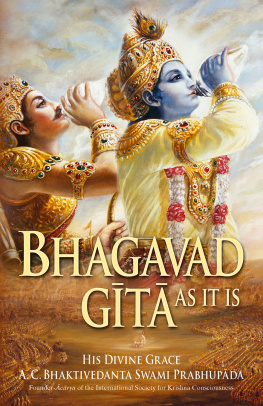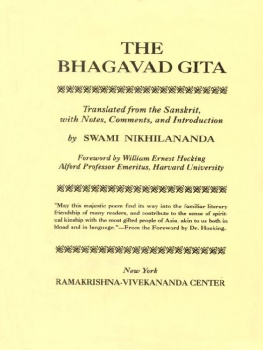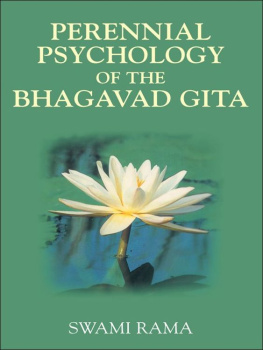Bhagavad Gt
In the Light of
Kashmir Shaivism
WITH ORIGINAL VIDEO
Revealed by
Swami Lakshmanjoo
John Hughes, Editor
Lakshmanjoo Academy
Published by:
Lakshmanjoo Academy
Copyright 2015 John Hughes
All rights reserved. No part of this book or the associated audio/ video recordings may be used or reproduced in any manner whatsoever without written permission. No part of this book may be stored in a retrieval system or transmitted in any form or by any means including electronic, electrostatic, magnetic tape, mechanical, photocopying, recording, or otherwise without the prior permission in writing of the publisher.
First printing 2013
Printed in the United States of America
For information, address:
Lakshmanjoo Academy
http://www.lakshmanjooacademy.org
ISBN 13: 978-0-9837833-4-3 (ebook)
T his pursuit is dedicated to Swamiji
to whom I owe everything.
Contents
Guide to Pronounciation
The following English words exemplify the pronunciation of selected Sanskit vowels and consonants. The Romanized Sanskit vowel or consonant is first listed and then an English word is given to aid you in its proper pronunciation.
| a | as | a in America. |
| as | a in father. |
| i | as | i in fill, lily. |
| as | i in police. |
| u | as | u in full. |
| as | u in rude. |
| i | as | ri in merrily. |
| as | ri in marine. |
| e | as | e in prey. |
| ai | as | ai in aisle. |
| o | as | o in stone. |
| au | as | ou in house |
| as | s in sure. |
| as | sh in shun, bush |
| s | as | s in saint, sun |
Preface
Kashmir Shaivism is a magnificently profound yet practical theology, which teaches the radical unity of God and creation. Kashmir Shaivism emphasizes the importance of an intellectual comprehension of its philosophy and cosmology as well as a direct realization of its truth. According to this system, truth cannot be grasped by the intellect alone; truth must finally be apprehended through direct experience. On account of its emphasis on praxis, Kashmir Shaivism has relied heavily upon its oral tradition, which, through an unbroken line of masters and disciples, has preserved and passed along the secrets and subtleties of its impeccably detailed path towards Self-realization.
Swami Lakshmanjoo embodies the teaching and experience of Kashmir Shaivism. He has a profound intellectual and spiritual understanding of this great tradition, which is made evident in all of his recorded lectures. Swamiji was an extraordinary man who dedicated his whole life to the study and practice of Kashmir Shaivism. He was a selfless devotee of Lord iva and his life was marked by the continual remembrance and celebration of the Divine.
Swamijis manner of teaching is traditional and inspiring. His lectures are always given through the medium of scripture. The verses he explains are in Sanskrit, the traditional philosophical and liturgical language of India. In all of his lectures, Swamiji chants the Sanskrit verses before translating and illuminating their meaning. His command of the Sanskrit language and his ability to explain the most difficult and esoteric concepts with simplicity and eloquence earned him an honorary degree Dr. of Letters from the Sampurnanand Sanskrit University in Varanasi (Benares) in 1965. This award was instigated by the eminent scholar Mahmahopadyya Pandit Gopinath Kaviraj, principal of the Sanskrit University.
Swamiji became interested in learning Sanskrit as a young boy. One day he overheard his father reciting verses from Utpaladevas ivastotrval. Swamiji was enchanted with the sound of these verses and asked his father to explain their meaning. His father admitted that he did not actually understand Sanskrit and was therefore unable to provide Swamiji with the meaning of the verses. Burning with the desire to know the meaning of these verses, Swamiji requested his father to find him a reputable teacher who could teach him Sanskrit. Pleased by this request, his father found him a reputable teacher and Swamiji began his study of Sanskrit.
Swamiji learned Sanskrit in the traditional fashion by first reciting and memorizing the 3,959 rules of Sanskrit grammar, which were composed by the great Sanskrit grammarian, Pini, in his masterwork, the Adhyy. Swamiji then began to study the language from the Kashmir Shaiva point of view. In doing so, he came to understand that every Sanskrit letter represented a particular element of the universe, and the entire body of the Sanskrit alphabet represented the kingdom of God. With a deep understanding of the fundamentals of the language, the constant guidance of his master, Swami Mahatabkak, and through his own contemplative experience, Swamiji was able to comprehend the meaning of every Kashmiri Shaivite scripture that he came across.
Swamiji was extremely well-read. He was well-informed in Eastern and Western religious and philosophical traditions. Swamiji would freely draw upon other texts and commentaries to further clarify, expand, and substantiate his lectures. He could recall any text by simply remembering the first few words of a verse. His mind was so clear and focused that he held countless verses in his active memory, and he could draw on them as needed. I once asked him if he ever forgot a verse. He replied, if I see or read anything, I remember it.
Bhagavad Gt
The Bhagavad Gt is one of the most celebrated and revered scriptures of India, if not the entire world. The Bhagavad Gt is understood to contain 700 verses. The unique version found in Kashmir, however, contains 716 verses. These additional sixteen verses are accepted by Abhinavagupta and are included in his forthcoming commentary on the Bhagavad Gt.
In 1933, at the age of twenty-six, Swamiji published Abhinavaguptas commentary of the Bhagavad Gt, the Gtrtha Sagraha (The Essence of the Lords Song). In the dedication at the end of this publication, Swamiji wrote the following lokas, which are paraphrased here:
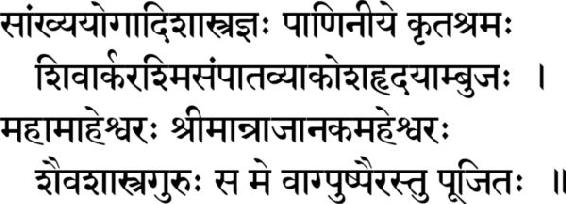
skhyayogdistraja pinye ktarama /
ivrkaramisaptavykoahdaymbuja //
mahmhevara rmnrjnakamahevara /
aivastraguru sa me vgpupairastu pjita //
My Sanskrit guru was fully informed in the understanding of Skhya and all Yoga stra. He had undergone the study of Pins grammar (adhyayi) and his heart-lotus had bloomed by the tvra aktipta of Parabhairava; he was devoted to Parabhairava. To him, Rjnaka Mahevara Rzdan, I give thanks wholeheartedly.

Next page
